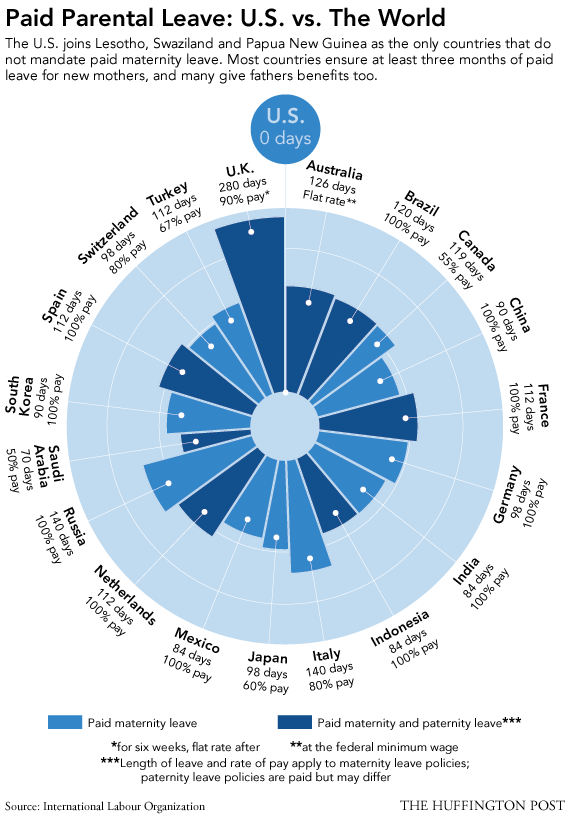By Alexander Casendino
“Today, we’re the only advanced country on Earth that doesn’t guarantee paid sick leave or paid maternity leave to our workers.” President Obama’s statement from his final State of the Union Address remains true; within the Organization for Economic Cooperation and Development, a consortium of 35 countries with developed economies, the U.S. is the only nation that does not guarantee paid family leave, a policy that mandates employers to provide paid time off work to employees taking care of a newborn child or a dependent family member.
President Obama’s remarks might not hold true for long, as presidential candidates, Donald Trump and Hillary Clinton, have both proposed plans to address the issue of paid family leave. Given their platforms and bipartisan public support, paid family leave will soon become a reality. However, neither of the policies proposed by these candidates provide the social and economic benefits for families that are standard in other parts of the world.
America’s shift toward paid family leave originates from long-term changes in the workforce. A June 2014 report from the Center for American Progress discovered the share of mothers who were breadwinners or co-breadwinners for their families increased from 1967 to 2012 by 35.8%. As a result, paid family leave has attracted support from mothers in breadwinner roles who must balance household finances and caring for a new child.
However, the Family Medical Leave Act (FMLA) of 1993 provided American workers with just twelve weeks of unpaid family leave. Business groups played a crucial role in restricting FMLA to only unpaid leave, arguing businesses would otherwise suffer from over-regulation. Since businesses have blocked a federal paid leave system, states including California have taken the initiative to address paid family leave.
Following a campaign spearheaded by several union organizations, California became the first state to pass a law mandating paid family leave in 2002. The policy has shown promising results; in a 2010 survey of California business owners, 91% of those surveyed reported the paid family leave program having a positive or neutral effect on profitability. California companies have not experienced losses because the program’s funding is supported by an employee payroll tax, which mandates workers to contribute a small fraction of their earnings into a distributional fund to pay for the paid leave program. While businesses initially opposed the policy, California’s paid family leave system has demonstrated employers can offer paid leave benefits without compromising their business’ profitability. California’s success marks the tip of the iceberg; a growing trend in favor of paid family leave is sweeping across America in 2016.
Paid family leave has bipartisan support. According to a nationwide survey released by the National Partnership for Women and Families in February 2016, 94% of Democrats and 61% of Republicans surveyed were in favor of a national paid family leave system. Paid family leave has even entered the 2016 presidential race. Both Trump and Clinton have introduced paid family leave plans remarkably different from each other.
Under Trump’s plan, working mothers would receive six weeks of paid family leave with payments through the unemployment insurance system. However, Trump’s plan excludes paternity leave and provides new mothers with just a fraction of their normal earnings because unemployment benefits vary in each state. This policy is considered Trump’s attempt to draw support from female voters, a voting bloc favoring Clinton over Trump by double digits.
Compared to Trump’s plan, Clinton’s plan provides a wider set of benefits. It mandates up to twelve weeks of leave guaranteeing parents two-thirds their regular salaries. However, both candidates’ plans are far less expansive than the benefits offered by most developed nations. According to a report issued in 2014 by the International Labor Organization, the U.S. mandates the shortest period of time off for new parents of all developed nations. In order to achieve long-lasting and impactful socioeconomic benefits, Trump and Clinton must take a stronger stance on paid family leave.

Rather than settling for either candidate’s plan, policymakers ought to converge portions of European countries’ systems and California’s program into a nationwide system. First, America should adopt the European policy of extending a national paid leave program to past fourteen weeks. This extension would contribute significant health benefits for children. A thirty-year study conducted by the University of North Carolina of sixteen European leave policies, each far more generous with time off provided to new parents than the U.S. policy, discovered paid leave programs can substantially reduce infant mortality rates. Infant mortality rates in the U.S. remain strikingly high compared to other advanced countries. An extended paid leave policy could drastically reduce the infant mortality rate in the U.S. and improve the welfare of children and parents alike. The U.S. can easily cover the cost of such a program by drawing a key part of the California paid leave system: a distributional fund, in which each worker contributes a sliver of their earnings to a national fund.
Around the world, policymakers understand helping workers meet their work and family obligations is sensible public policy. Paid leave is good for the economy, public health, and families. It is past time for the U.S. to join the trend and adopt paid family leave policies to help millions of Americans. Clinton and Trump have broadened the national interest in paid family leave by drafting separate paid family leave plans. However, the U.S. must take additional steps for a stronger family leave policy compared to the propositions made by these candidates for the sake of businesses, parents, and children alike.
Featured Image Source: cafeboulud.com






One Comment